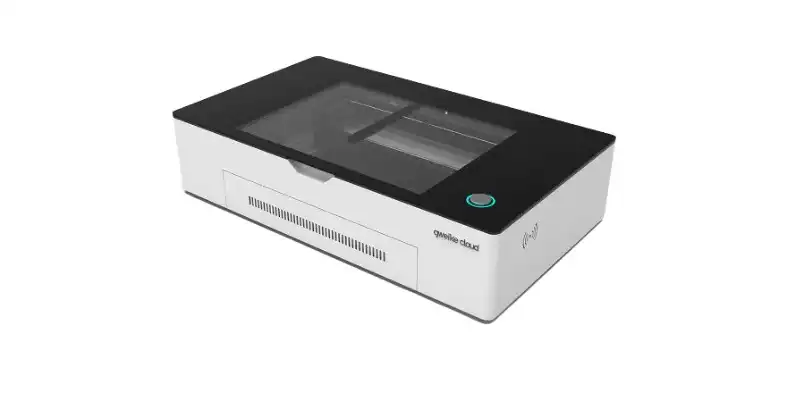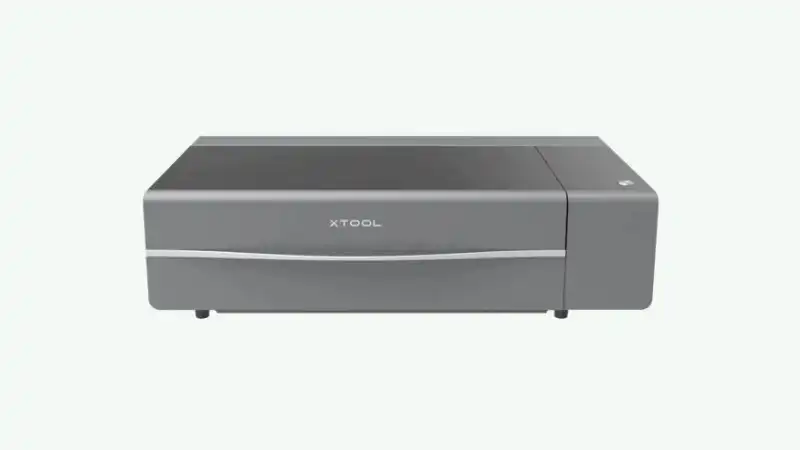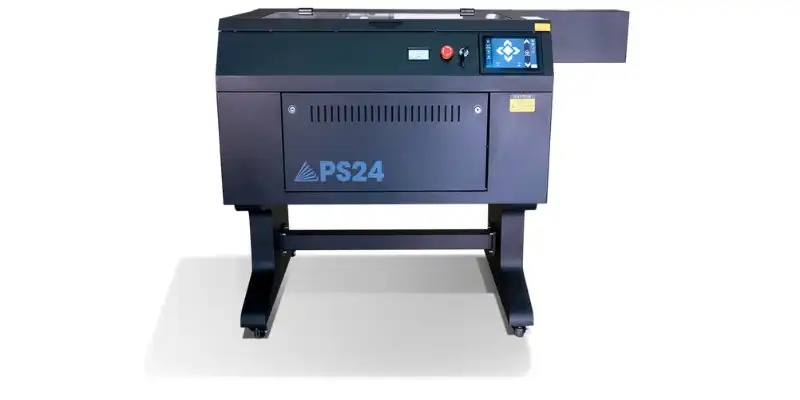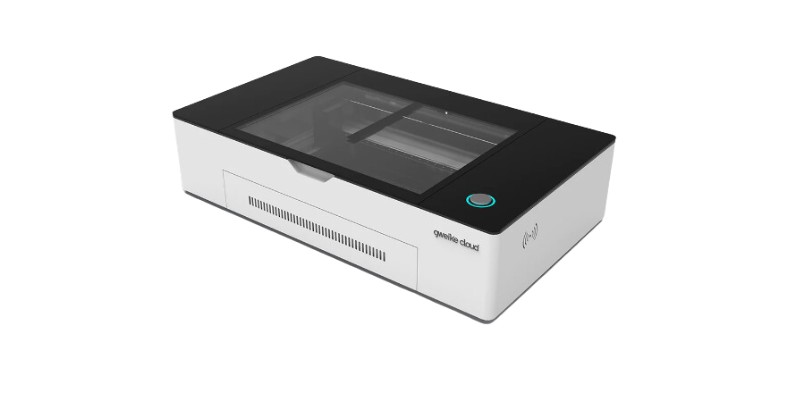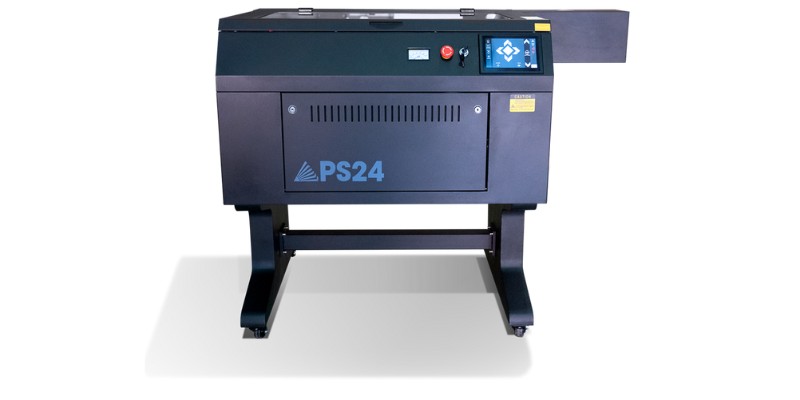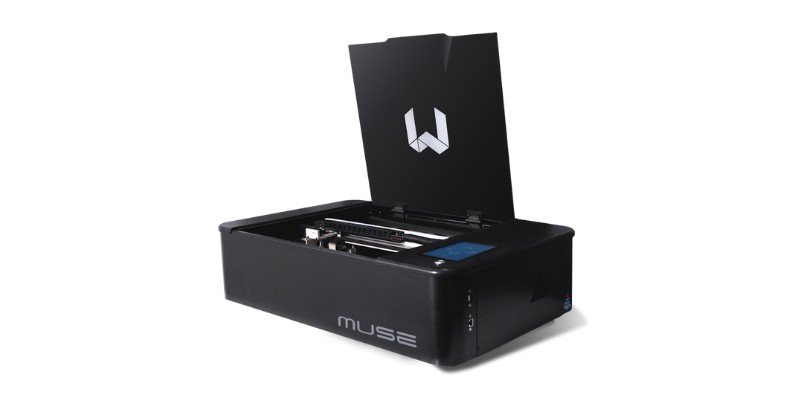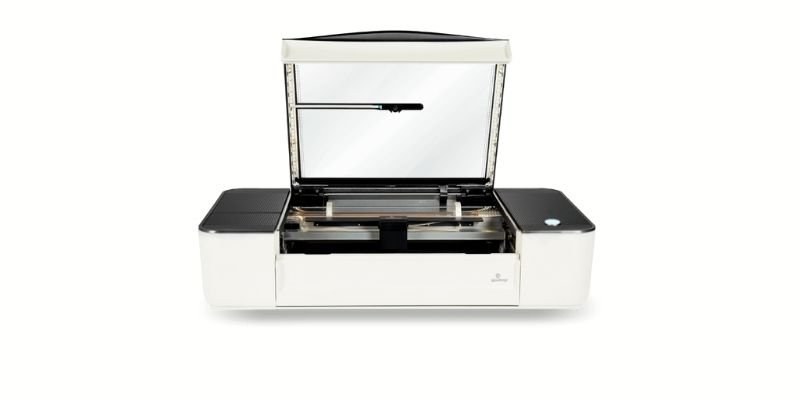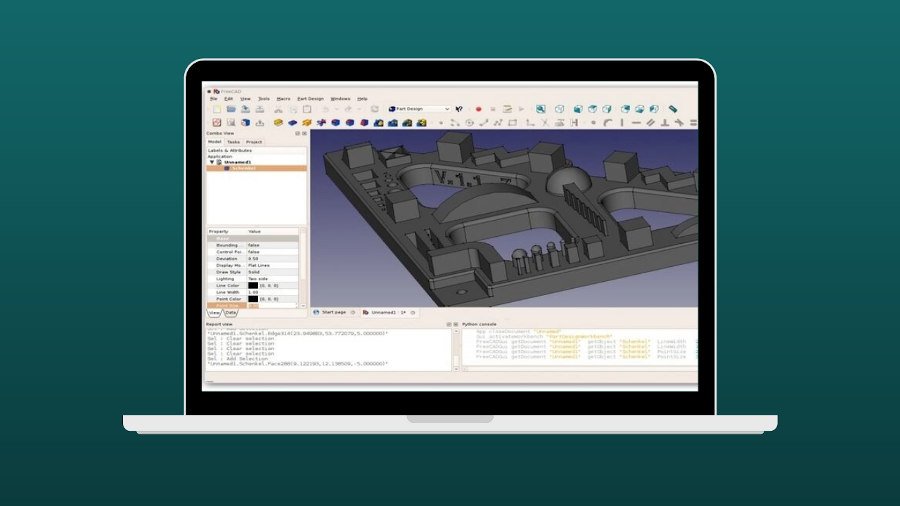CO2 laser cutters are ideal for small businesses wanting to quickly cut through thicker acrylic and wood in a single pass, and cut through clear acrylic sheets. The best CO2 laser cutters combine high power with accessories like rotary attachments, and pass-through slots and automatic feeders, to maximize efficiency.
But since they vary so much in price, it can be confusing trying to figure out which CO2 laser best suits your particular needs. You don’t want to overspend, but you also don’t want to shell out on a machine that can’t do what you need.
Overall, based on my hands-on testing, I recommend the xTool P2 as the best CO2 laser cutter under $10,000.
The P2’s powerful 55W power, large working area, riser base and RA2 rotary attacchments are affordable and extremely effective, and it also has amazing curved surface engraving features.
|
CNCSourced Rating: |
CNCSourced Rating: |
CNCSourced Rating: |
|
4.2
|
4.7
|
4.5
|
|
Working Area:
510x300mm
|
Working Area:
600 x 308 mm
|
Working Area:
24”x16”
|
|
Laser Power:
50W
|
Laser Power:
55W
|
Laser Power:
90W
|
|
Range of available attachments:
rotary attachment
|
Range of available attachments:
rotary attachment, riser base, automatic conveyor feeder
|
Range of available attachments:
rotary attachment, fume extractor
|
|
$2,800
|
$4,499
|
$8,995
|
|
|
|
|
Read more: the complete laser cutter buyer’s guide (including non-CO2)
Quick Overview
- xTool P2 – Best Desktop CO2 Laser Overall
- Gweiki Cloud Basic 2
- Flux Beamo 30 W – Best Budget CO2 Laser Cutter
- FSL Pro Series PS24
- OMTech 70 W – Best OMTech Laser
- Full Spectrum Laser Muse Core – Most Affordable High-end Laser Cutter
- Glowforge Pro – Best Professional CO2 Laser Cutter Overall
- OMTech Polar 350
- OMTech 40 W – Cheapest CO2 Laser
In this guide, I’ll share my hands-on experience with all of the best CO2 laser cutters on the market, and compare all of the key factors to help you make a confident choice.
The Top CO2 Laser Cutters Ranked
1. xTool P2 – Best Desktop CO2 Laser
- Price: Check latest price at xTool here
- Working area: 600 x 308 mm
- Laser type: CO2
- Power: 55W
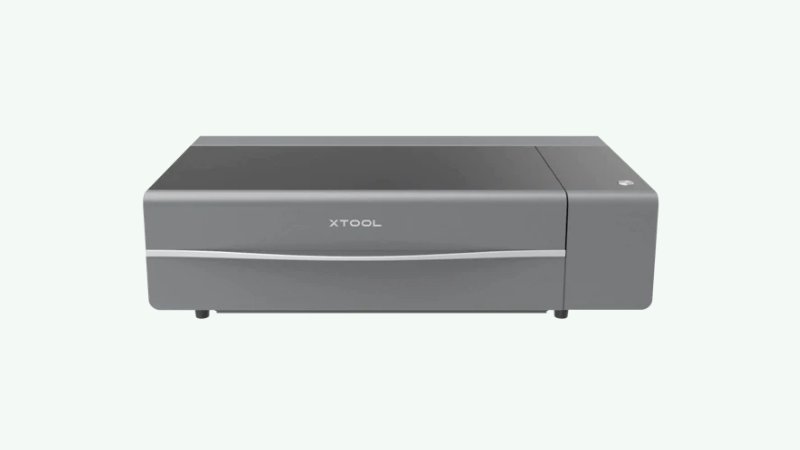
Pros
55W is higher power than Glowforge, Gweike, OMTech Polar
Fast 600mm/s max engraving speed
Larger build volume than competitors
Curved surface engraving features, and batch processing features
Low-cost rotary and riser base accessories
Cons
Slightly more expensive than Gweike Cloud Pro (but well worth it)
Slightly lower dpi than Glowforge Pro (1355dpi vs 1000dpi)
Based on my hands-on testing, the xTool P2 is currently the best desktop CO2 laser, and stands above competitors like the Glowforge Pro, OMTech Polar, and Gweike Cloud Pro.
With 55W of power, the P2 surpasses even the 50W Gweike model and far exceeds the 45W Glowforge Pro. Its professional-grade 600mm/sec speed is twice as fast as the Glowforge Pro (around 300mm/s), and also faster than the OMTech Polar (500mm/s).
The extra-large 24″ x 12″ work area provides ample room for larger sheet laser cutting, and is larger than the Glowforge, Gweike Cloud Pro, and OMTech Pro. The 2.5” max height is slightly taller than these lasers which have 2”, but I personally bought the riser base accessory which gives you up to 8.5” height, which also makes rotary engraving much easier.
The 16MP dual auto-focus cameras make setting up your projects really simple. Most importantly though, they have the ability to scan the surface of your workpiece, so you can engrave curved surfaces with complete accuracy. The cameras create a kind of 3D scan, and adapt based on the height at each point so your laser engraving doesn’t distort.
You can see how this works on this wooden spoon I tested:
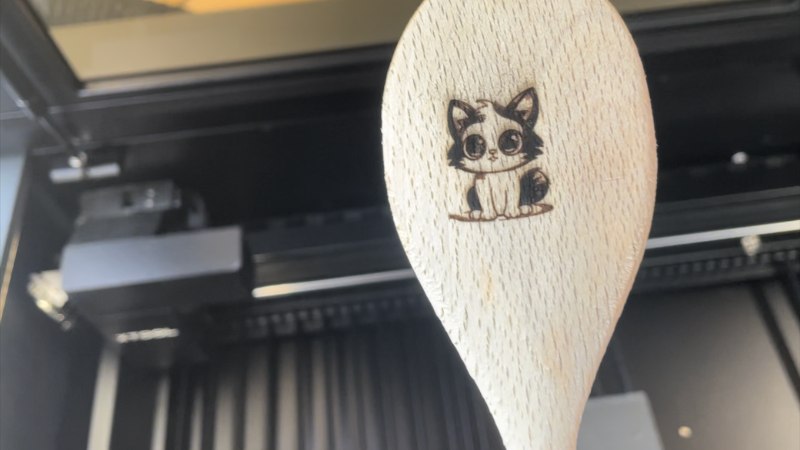
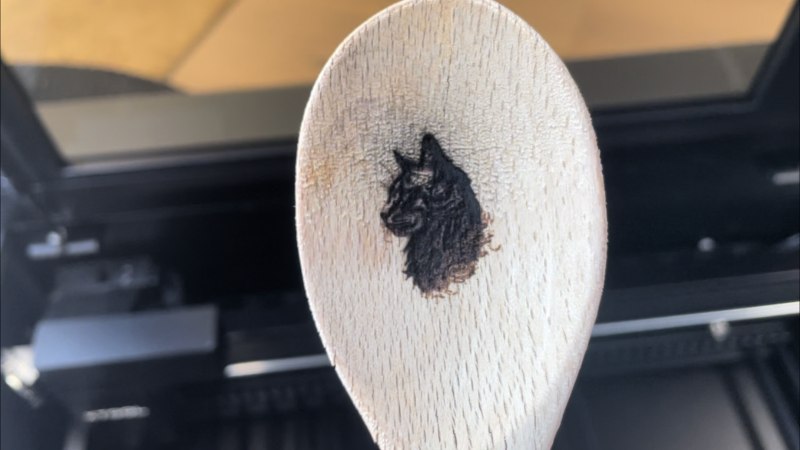
And here’s the video I also made covering this:
As well as the rotary and riser base, there’s also the automatic conveyor feeder, which lets you feed in up to 118-inch workpieces for laser cutting – opening up a whole new range of possibilities for your small business or home projects.
You can use the xTool P2 with Lightburn, but the XCS software is actually really good. You’ll need it for the batch processing features, which automatically aligns your design on any other workpieces once you align the first.
This is ideal if you’re engraving a bunch of leather patches, coasters, or metal jewelry with the same design at once.
Here’s how it looks in action:
Overall, I think the xTool P2 is the king of desktop CO2 lasers right now, and it’s definitely the best CO2 laser cutter under $5000.
Simple the best CO2 desktop laser right now. You can buy this, the rotary, riser base, and the automatic conveyor feeder, and it's still cheaper than a Glowforge Pro.
It's more powerful than competing lasers at 55W, can cut 20mm thick wood in a single pass, and the batch processing and curved surface engraving open up new possibilities for your business.
- Large processing area
- Powerful 55W laser cuts 20mm thick material in a single pass
- 16MP dual cameras autofocus for easy project preparation
- Curved surface engraving in XCS
- Batch processing features
- Can't use all features in Lightburn (but XCS software is really good now)
- Mirrors/lenses may be out of focus from transport and require fixing
2. Gweike Cloud Basic 2
- Price: $2,800 — Available at Gweike Cloud here
- Power: 50W
- Working area: 510x300mm
- Software compatibility: Lightburn, Cloud Control Online, Gweikecloud Software
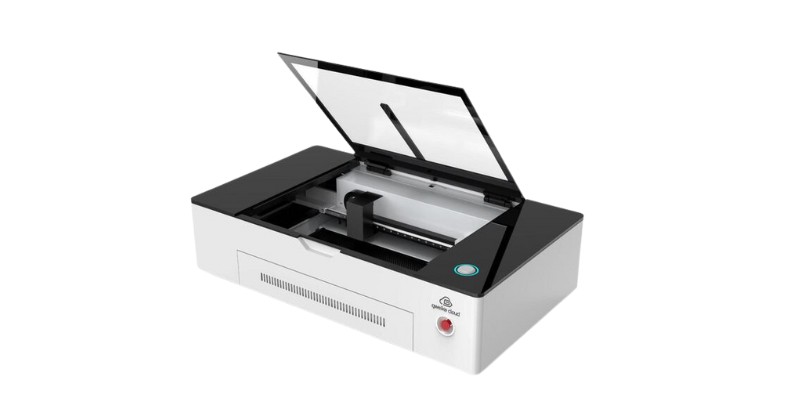
Pros
Great value for money
600mm/s cutting speed equals more expensive machines
Highly intuitive with 5MP camera, easy focus, and safety features
Variety of software options for offline and online working
Cons
Smaller working area than P2 and lower dpi than Glowforge Pro
The Gweike Cloud Basic 2 is a solid option if you’re looking for an affordable CO2 laser engraver.
It packs a punch with a 50W laser. This is around half the price of the Glowforge Pro, despite having a more powerful laser.
It’s also one of the fastest budget CO2 lasers out there, with a really impressive 600mm/s cutting speed, which is equal to premium machines like the xTool P2.
This laser is also highly intuitive, with a 5MP camera that allows you to preview jobs and accurately lay out your designs. The camera also allows you to extract the surface pattern of any object and cut or engrave the recognized pattern with a precision of 1000dpi, making it easy to achieve stunning results. This precision is equal to the xTool P2’s, but lower than the Glowforge Pro’s (1355dpi) for reference.
The Basic 2 also comes with a rotary attachment included, whereas other lasers often require you to purchase it separately, adding to the total investment in your laser business.
I’m personally a big fan of lasers that let you use any software you want. Whereas Glowforge really limits you here, companies like Gweike and xTool let you use Lightburn – and Gweike also lets you use their own cloud software, Cloud Control, and Lightburn. This means you can run the Basic 2 while offline or online, depending on your preference.
Despite its pros, the Gweike Cloud Basic 2 does have a few limitations.
One of the main ones is its working area, which is around 100mm smaller than the xTool P2’s. That being said, its working area is still pretty decent for the price, and it does also have a passthrough slot for feeding through longer materials. However, its 5MP camera is also lower quality than the 16MP one used in the xTool P2, and the P2 also has depth sensors for engraving curved surfaces which really is incredible!!
Overall, though, I think this laser is right up there with the best CO2 lasers for hobbyists and small businesses. It particularly stands out for its value for money, offering the same speed and dpi as some more expensive machines.
That being said, I still think the increased power, size, and significantly better cameras mean the xTool P2 is an overall better machine. But, the Gweike Cloud Basic 2 is a fantastic option for anyone with a budget of around $3,000.
3. Flux Beamo 30 W – Best Budget CO2 Laser Cutter
- Price: $1,995 — Available at Matterhackers here
- Materials: Metal, stone, tile, wood, cardboard, paper, glass acrylic, fabric, leather
- Cutting area: 300 x 210 mm
- Power: 30W
- Software compatibility: Beamo studio
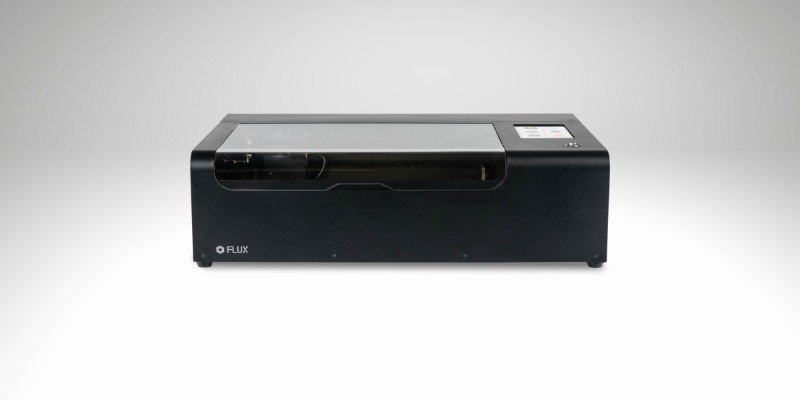
Pros
Excellent safety features.
Powerful and easy to use.
Great support is offered by Flux with their own Beamo Studio software.
Cons
Expensive for an entry-level CO2 laser cutter.
For our next laser cutting machine, we go up quite a bit in price, but also in power.
The Flux Beamo 30 W is listed as an entry-level laser cutter, and it absolutely is in terms of ease-of-use, however, with this price point, we recommend it as an entry-level cutter for small businesses rather than individual use.
What’s great about the Beamo is this pipeline of support offered by Flux with their own Beamo Studio software. Here you’ll draw in app designs, while still being able to import from popular software like AutoCAD and Adobe.
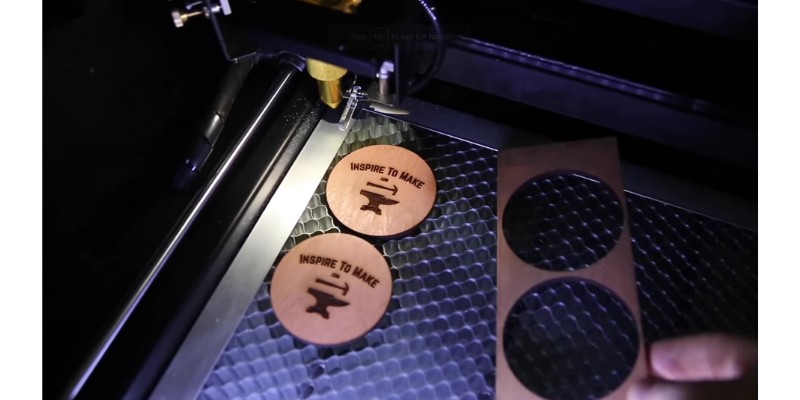
There are also excellent safety features like its ability to pause mid-job when opened, and its flexible exhaust pipe that allows you to direct potentially harmful smoke away from people and the work area. There’s even an upgrade, the BeamAir filtration unit, which filters the smoke and air coming from the machine, so you don’t have to rely on windows or doors to ventilate.
Other upgrades include automatic laser focusing, although manual focusing is still streamlined and easy.
From the software to the actual application of the machine, everything is simple, which makes it perfect for new users who don’t want to get bogged down by a huge learning curve but still want a machine with power.
Cheaper than the FSL Muse, but you lose 10W laser power. A great mid-range and versatile pick.
4. FSL Pro Series PS24
- Price: $8,995 – Available at Matterhackers here
- Power: 90W
- Working area: 24”x16”
- Software compatibility: RetinaEngrave v3.0
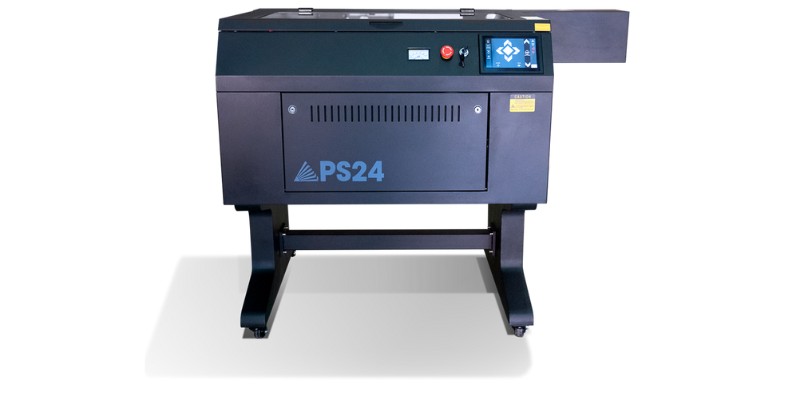
Pros
Powerful 90W laser
Large working area with passthrough slot
Rotary roller and chuck rotary available
7” LCD touchscreen
Cons
Expensive, particularly with all accessories
Only compatible with FLS’s software
If you like the look of the FLS Muse Core but are after more power or working area, it’s worth checking out the FSL Pro Series PS24.
The main difference between this model and the others on our list is its size and laser power. It’s the biggest, with a working area of 24”x16” (610x406mm), which is larger than the xTool P2 and far larger than the Polar 350. It also has passthrough doors, so you can feed through even longer materials.
With 90W power, it’s also significantly stronger than most hobbyist CO2 lasers. You can cut far deeper with this 90W CO2 laser in a single pass than with 40-60W lasers.
The P24 is designed for heavy-duty work. For example, it’s ideal if your business involves processing large signs or advertisement boards, or cutting thick wood at fast rates. You can add a rotary attachment for processing large cylindrical products, such as baseball bats.
Of course, these specs also come at a cost, as the PS24 is a fair bit more expensive than the other models we’ve reviewed. This price goes up even more if you add extras like the rotary attachment ($1,000) or the fume extractor ($3,275).
The PS24 does lack some of the more intuitive features seen in the xTool P2 and Gweike Cloud, like a built-in camera, although it does have a 7” LCD touchscreen for better control over your projects.
Another thing to bear in mind is that it’s only compatible with one software: Full Spectrum Laser’s RetinaEngrave v3.0.
While RetinaEngarve is decent, it’s browser-based only, and means you can’t use the PS24 with other popular programs like Lightburn. This reduces your options as compared with other lasers on this list.
5. OMTech 70 W – Best OMTech Laser
- Price: Check latest price at Amazon here
- Materials: Acrylic, plexiglass, stainless steel, fabrics, leather, marble, titanium
- Cutting area: 395 x 750 mm
- Power: 70W
- Software compatibility: Lightburn
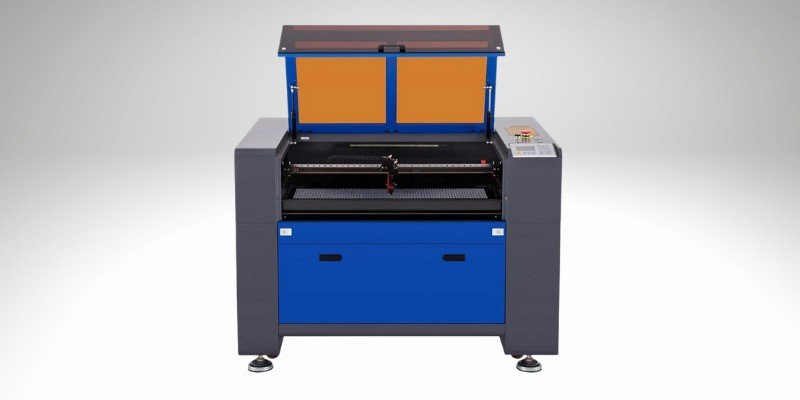
Pros
Good cutting depth of 7mm.
Can cut a range of materials like stainless steel and titanium.
Perfect for professionals that work on large-scale projects.
Cons
Too powerful for a beginner.
Another cutter from the OMTech family, the 70 W is a more robust version of the 40 W. We see that clearly in the range of materials it cuts, as there are the additions of metals like stainless steel and titanium, and other hard surfaces like marble and stone.
The cutting depth also shoots up from 2-3 mm thick to 7 mm, significantly changing the level of achievable cutting and engraving, as well as demonstrating the immense increase in power.
Other upgrades with this model include autofocusing and a 4-way pass-through system. Now at a touch of a button, your machine is focused and ready to go and is open on four sides, working on objects larger than the machine itself. It also has an adjustable bed and is compatible with the ever-popular LightBurn laser control software.
The 70 W is definitely an investment and best for professionals that work on larger-scale projects. The machine itself is also quite big, so make sure there’s room for a 126 x 87 x 92 cm cutter.
We also argue this is a fair option in place of the Orion Motor Tech 80w CO2 laser engraver cutter, which is more expensive. The 70 W also has a lot of the same features advertised in the 80 W, like autofocusing and four-way pass-through.
6. Full Spectrum Laser Muse Core – Most Affordable High-end Laser Cutter
- Price: $3,500 — Available at Matterhackers here
- Materials: Wood, leather, paper, acrylic, fabric, rubber
- Cutting area: 508 x 305 mm
- Power: 40W
- Software compatibility: RetinaEngrave
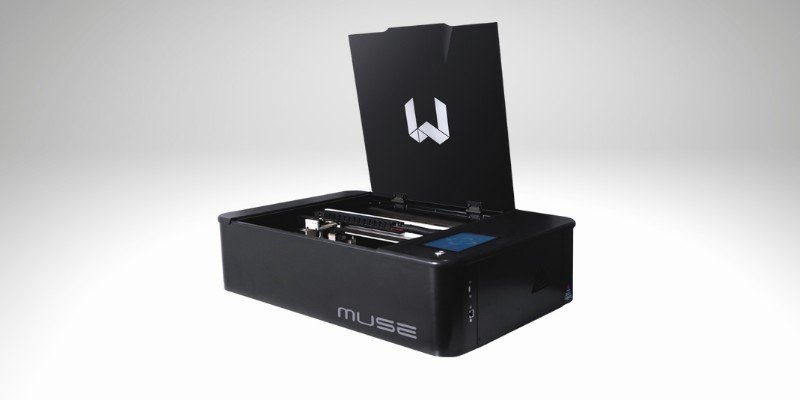
Pros
Comes with a removable bed, so it works on projects larger than itself.
Has a unique 3D camera option that works with curved surfaces and uses millions of 3D data points to create accurate work.
Multiple attachments are available.
Cons
Not as versatile as Glowforge.
As we enter the high-end spectrum, you’ll start to see more optimized features like in the FSL Muse Core.
Now, the Muse may not be as versatile as its main competitor, Glowforge, when it comes to materials, but it’s a fierce Glowforge alternative, and what it does cut, it does incredibly well. It stems from a US-based company that’s renowned for its industrial cutters, so rest assured you’re getting a fantastic model.
As expected at this price, the cutter comes with a removal bed, so it works on projects larger than itself, autofocusing, and has a unique 3D camera option that works with curved surfaces and uses millions of 3D data points to create accurate work.
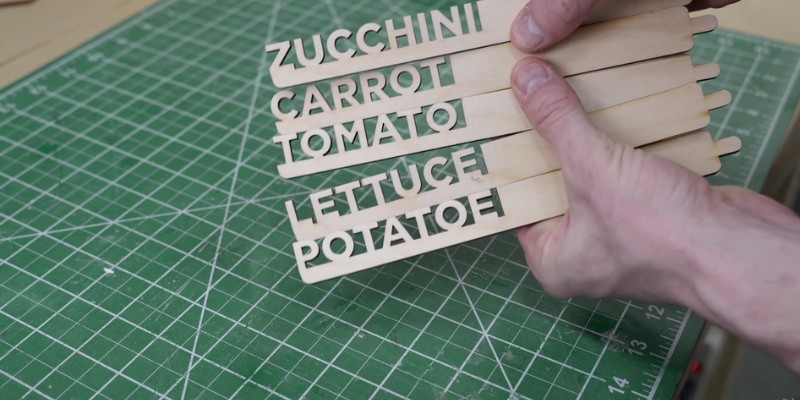
Other bonuses include its browser-based software, which doesn’t require an internet connection to work, and its ability to cut up to ¼ inch thick.
The big draw for this machine, though, is its attachments. Water cooling, air compressors, fume extractors, rotaries, lenses, and tube upgrades effectively let you build this machine to your desired standards and allow you to maximize on versatility and efficiency.
So, if you are working mainly with wood, acrylic, and leather materials, but want the functionality and performance of a high-end cutter, then this is the model for you.
Powerful 40W laser matches the Glowforge - but at a more affordable price point and with more upgradeability.
7. Glowforge Pro – Best Professional CO2 Laser Cutter Overall
- Price: $5,995 — Available at Glowforge here / Dynamism here
- Materials: Wood, paper, acrylic, rubber, leather, fabric, glass, ceramic, titanium
- Cutting area: 279 x 495 mm
- Power: 45W
- Software compatibility: Glowforge web-based software
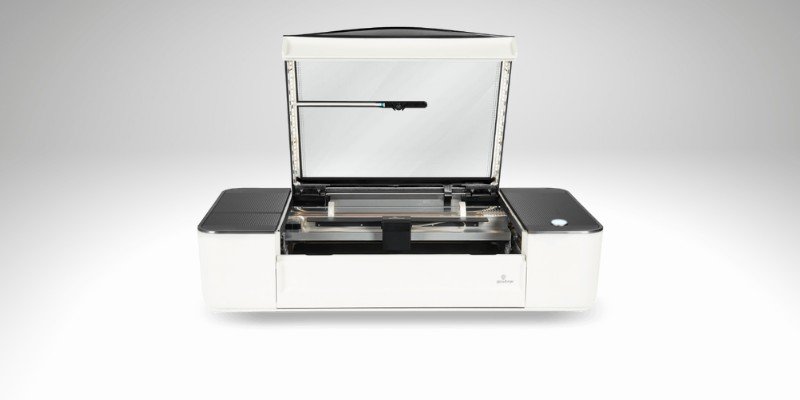
Pros
Sturdy and sleek design.
Has a pass-through system, so depth-wise dimensions could be endless.
Has optimized features like water cooling and an air compressor.
Perfect choice for precision-heavy, large-scale work.
Cons
No major drawbacks.
The Glowforge Pro is an absolute beast of a desktop CO2 laser cutter, boasting a powerful 45w CO2 laser tube and a sturdy yet sleek design.
Unlike the cheaper Glowforge models, it has a pass-through system, so depth-wise the dimension could be endless. It cuts up to 0.5-inch thick of material, depending on its hardness, and comes with an auto-focused lens and unique cloud-based software that does require the internet to work.
It also has optimized features like water cooling and an air compressor, which not only means it works for longer, but it also means it’s safer and boasts the precision of up to 1/1000 of an inch.
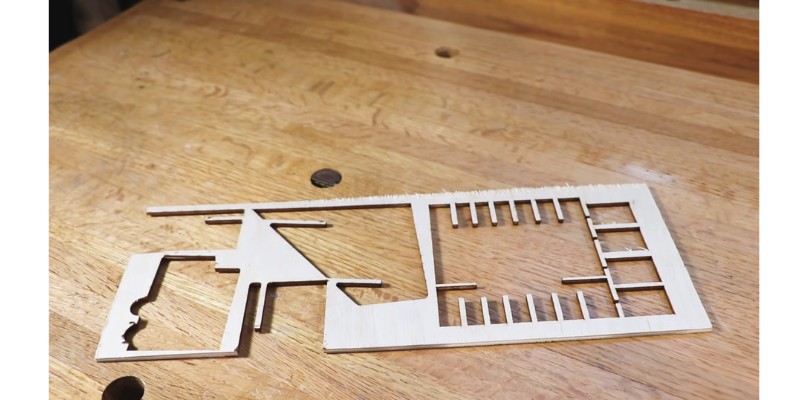
Even though we’re highlighting the Glowforge Pro, the Basic and Plus are equally fantastic CO2 laser cutters if you’re dead set on the brand but prefer a cheaper model and fewer facilities. However, if you’re just concerned with price, then we suggest sticking to this list to get the best price-to-feature ratio.
Overall, the Glowforge Pro feels futuristic with its minimalist design and integration of cutting-edge technology like the cloud and Proofgrade materials, making it the perfect choice for precision-heavy, large-scale work. It’s also worth noting this is a class 4 laser, but the machine does come with all the necessary safety training materials.
Glowforge are the easiest to use lasers for home business owners looking to create cool projects and sell them on Etsy or other stores and make money.
8. OMTech Polar 350
- Price: $2,999.99 – Available at OMTech here
- Power: 50W
- Working area: 510x300mm
- Software compatibility: RDWorks, Lightburn
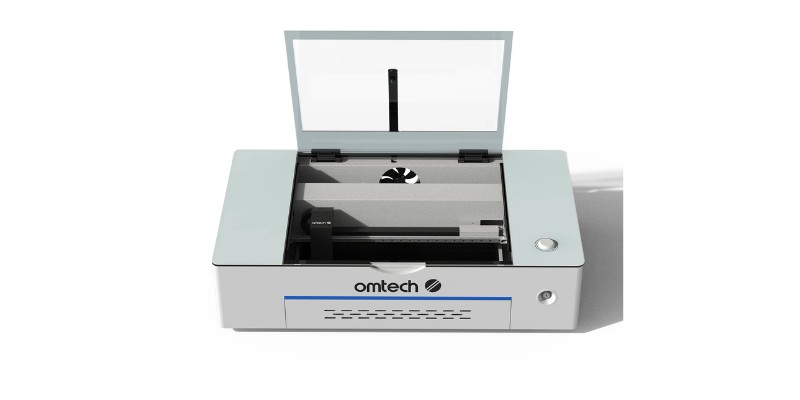
Pros
Fast and accurate engraving at a great price
Very user-friendly with 360-degree panoramic camera
Comes fully assembled
Rotary attachment included
Cons
500mm/s is slightly slower than Gweike Cloud Basic 2 and xTool P2
Another OMTech model to consider is its new Polar 350. This machine is fairly different to other OMTech machines as the Polar 350 is a more modern and intuitive machine, with more quality-of-life features that make it easier to use.
This is why it’s a lot more expensive than the OMTech 40W, despite having just 10W more power. It’s around the same price as the 70W OMTech model, despite having 20W less power.
The Polar 350 cuts wood up to 10mm deep in a single pass. Its 500mm/s engraving speed is impressive for a machine under $3K – though it does slightly lag behind the Gweike Cloud 50W and xTool P2.
The Polar also has a 5MP 360-degree panoramic camera, allowing you to monitor your work in real-time, and drag and drop the size and position of patterns for perfect placement. The easy auto-focus feature enhances the user experience.
This machine comes almost fully assembled so you can use it virtually straight out of the box, and has a number of built-in safety features for maximum safety. It’s designed to be used with Lightburn, although you have to buy the program separately. Alternatively, an RDWorks software license comes included.
The 510x300mm working area puts it in line with other high-quality CO2 lasers, and it also has a passthrough slot to support longer objects. Like the Gweike Cloud Basic 2, this model comes with a rotary attachment included.
We put the Polar 350 above the Glowforge Pro due to its great value and on par with the Gweike Cloud 50W – there’s almost nothing to separate the Gweike and OMTech. They’re basically the same.
However, I do still prefer the xTool P2 overall due to its higher quality camera, more powerful laser, and greater upgrade options.
9. OMTech 40 W – Cheapest CO2 Laser Cutter
- Price: Check price at Amazon here
- Materials: Wood, leather, rubber, paper, cardboard, acrylic
- Cutting area: 320 x 200 mm
- Power: 40W
- Software compatibility: LaserDRW and Coreldraw
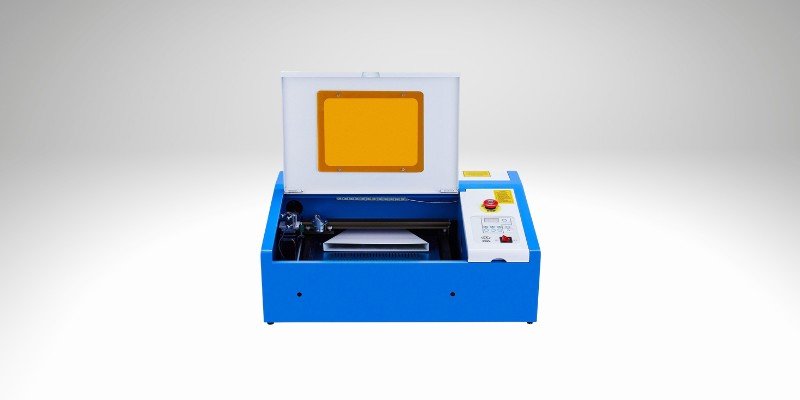
Pros
Budget-friendly option.
Great for designing jewelry, leather wallets, and other small-scale projects.
One of the best entry-level CO2 laser cutters available.
Cons
Small working area.
OMTech is the American branch of the China-based company Orion Motor Tech, which imports the laser cutters and completes quality assurance checks and warranties before selling them in the US. So, if you’re looking for the Orion Motor Tech 40 W CO2 laser engraver cutter, then what you really want is the OMTech 40 W.
This means US-based customer service and shipping, which is ideal if you’re in the country.
The 40 W is a budget-friendly option in the long line of OMTech CO2 laser cutters. It comes preassembled with a sturdy, compact build that sits comfortably on your desk or tabletop.
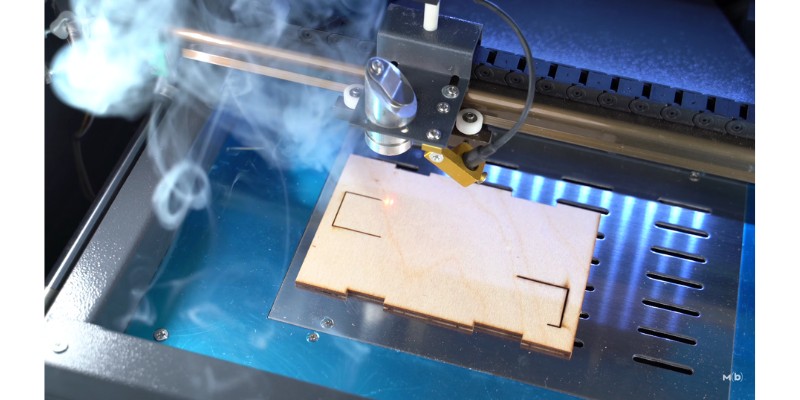
With a working area of 320 x 200 mm, you’re not going to be cutting and engraving wood planks or acrylic slabs anytime soon, but you will be intricately designing jewelry, leather wallets, and other small-scale projects with professional finesse.
Its cutting depth sits at around 2-3 mm, giving you confident single pass cutting, and has a laser pointer for pinpoint accuracy. Despite its size and price, the 40 W also comes with optimized ventilation, sporting a flexible tube and internal fan that help target smoke output away from your work area.
Overall, this is hands down one of the best entry-level CO2 laser cutters on the market, and nearly every list will say so. And when you want a bit more, there are popular upgrades like a tube laser, water pump, and better exhaust fan that allow you to adapt the machine to your growing needs.
This machine is likely the most sought-after entry-level CO2 laser cutter on the market, and because of its 40 W laser tube, it's also a popular entry-level glass engraver.
What Is a CO2 Laser Cutter?
A CO2 laser cutter directs a focused beam of infrared laser light produced by exciting carbon dioxide gas to precisely cut or engrave materials like wood, plastic, acrylics, glass, and leather.
They work by directing a focused beam of infrared laser light, produced by exciting carbon dioxide gas, at the material to melt or vaporize it.
These beams are amplified using mirrors to concentrate the beam, resulting in a powerful laser that can cut and engrave a variety of materials. The gas mixture is typically made up of carbon dioxide, hydrogen, nitrogen, and helium.
They aren’t best for strong metals or metallics, although some models handle sheets of aluminum and other non-ferrous metals. Some users try to increase the power of the CO2 laser cutter by increasing oxygen content, but this is only done on machines built to handle such enhancements, and should only be done by a professional.
How to Choose a CO2 Laser Cutter
Now that you’ve seen the models and know what they’re used for, it’s time to decide which CO2 laser cutter to buy.
The first thing to consider is your experience. If you’re new to the game of CNC machines, regardless of how experienced you are as an engraver or carver, then you’ll want an entry-level laser cutter. These will be the easiest to use and often the cheapest option available and ensure you’re not out of thousands if you make a mistake while learning.
Next, think about what you’re using the machine for. If you know you’re going to need a laser cutter and engraver for slate, hardwood, stone, marble, titanium, and other tougher materials, then you’ll need a higher-end model that has the power to handle those materials. If you work mainly with softer materials, then save a few bucks by opting for the Flux Beamo or OMTech 70W.
Finally, decide your budget. You want your investment in a CO2 laser cutter to be profitable, not a money pit. Set realistic expectations for your budget, as well as future monetary targets, before buying one of the best laser cutters, and make sure it falls within those boundaries.
What can you do with a CO2 laser cutter?
Let’s now take a look at the main uses of CO2 laser cutters and how those differ from diode lasers.
Create Large & Long Projects, Quickly
CO2 lasers often have a passthrough slot. This allows you to pass through longer materials as you’re not constrained by the working area.
For example, the xTool P2 can support materials up to 118” long at a time if you have the conveyor feeder attachment, while the Glowforge Pro can support unlimited length.
This makes CO2 lasers ideal for projects like wakeboards, surfboards, and signs.
Some CO2 lasers also allow you to extend the cutting height with upgrade components like a riser base. For example, you can boost the P2’s cutting height to 8.5”, whereas most other lasers max out at around 2”. This is ideal for working on taller projects, and is also essential for fitting a rotary engraver in your build area.
Small Business Processing
While some people do use diode lasers for small businesses, CO2 lasers have higher cutting speeds and breeze through jobs many times faster.
For example, the xTool D1 Pro diode laser has a max cutting speed of 400mm/s, which is impressive, but the xTool P2 CO2 laser is much faster at 600mm/s. And, it can cut through thicker materials at a far faster speed – the gains are even larger than the maximum engraving speeds show.
If you want to build a profitable and effective business, therefore, CO2 lasers are far better than diodes. The cameras CO2 lasers often let you better line up your projects, too, so there’s less waste on each material sheet from not fitting projects in as well. (You can also use laser nesting software to help with this!)
CO2 laser’s increased power is just going to make life that much easier, particularly if you’re working with thick, hard materials like acrylic and hardwoods.
Intricate Engravings
As well as being able to quickly cut thick wood and other materials, the best CO2 laser engravers are also capable of achieving highly precise etchings. The likes of the Flux Beamo, Gweike Cloud Basic 2, and xTool D1 Pro all have 1000dpi resolution, while the Glowforge Pro has 1350dpi.
This allows you to produce extremely accurate engravings of intricate and complex designs, such as photos, portraits, and other types of laser art.
However, for general engraving on wood, a diode laser like the xTool D1 Pro can work fine. These diode lasers usually have a smaller spot size than CO2 lasers, though it’s barely perceptible in all honesty.
Materials CO2 lasers can cut:
- Wood
- Aluminum
- MDF
- Paper
- Leather
- Plastic
- Fabric
- Derlin
- Melamine
- Mylar
- Rubber
- Ceramic
Materials CO2 lasers can engrave:
- Coated non-ferrous metals (aluminum, stainless steel)
- Glass
- Stone
Note: bear in mind that CO2 lasers aren’t suitable for engraving non-coated metals, whether they be non-ferrous metals or ferrous metals like gold and silver. This is because the wavelength of CO2 lasers is mostly reflected by metal surfaces. For metal engraving, you’re best off using either an infrared or fiber laser engraver.
How to choose the right CO2 laser machine for you
Now let’s take a look at the key factors to consider when picking a CO2 laser cutter:
Price
CO2 lasers vary in price from $500 to tens of thousands of dollars. Spending $3,000 or less gets you a small, budget machine with 30W to 50W of power like the Flux Beamo, while $3,000 to $7,000 can get you larger, more powerful machines for medium size jobs, like the xTool P2.
When you get to $8,000 and above you start looking at professional CO2 lasers with upwards of 70W power and large working areas, such as the FLS P24. Industrial CO2 lasers can cost tens of thousands.
Power
The more power, the deeper you can cut in a single pass, and the faster you can cut.
For example:
- The Flux Beamo is a 30W laser and can cut 5mm wood in a single pass.
- The Gweike Cloud Basic 2 is a 50W laser and can cut 15mm wood in a single pass.
- The xTool P2 is a 55W laser and can cut 18mm wood in a single pass.
Engraving resolution
The engraving resolution determines the precision you can achieve when engraving intricate designs. Machines like the Flux Beamo and Gweike Cloud Basic 2 have resolutions of 1000dpi, which is more than enough for most projects.
However, if you were looking to do highly intricate photo engraving, for example, you may look for a higher resolution machine like the Glowforge Pro, which offers 1350 dpi.
Size
A CO2 laser’s size and working area can vary a lot, and also has a big impact on price. The Flux Beamo is one of the smallest and cheapest machines, with a working area of just 300x210mm designed for small projects.
Then you get medium-sized machines like the xTool P2, Gweike Cloud Basic 2, and Glowforge Pro, which average around 500/600x300mm. These machines all also have passthrough slots, allowing you to feed in longer sheets of materials.
CO2 lasers designed for business and industry are much larger, but also cost a lot more.
Use and applications
Think about how much space you have in your workshop, what you want to sell or create for your business, and use this article to help find which laser is best suited for your specific needs!
For example, if you’re looking for a desktop-friendly machine for small, low-intensity craft projects, the Flux Beamo is a good choice.
If you’re looking for a larger, faster, more powerful machine with better cutting capability, the xTool P2 is a better choice as part of a small business.
FAQs
What’s better, a CO2 laser or a fiber laser?
Fiber lasers are the most powerful type of laser and are widely considered better for working with metals, but CO2 lasers are often preferred for wood and other non-metals. You can read our fiber vs CO2 laser comparison to learn more.
Other laser cutter buyer’s guides:
- Best acrylic laser cutters (including CO2)
- Best laser cutters for leather (including CO2)
- Best laser engravers for metal etching
- Best industrial laser engravers
- The best laser cutting machines for small businesses
- The top laser cutter rotary attachments and combos

